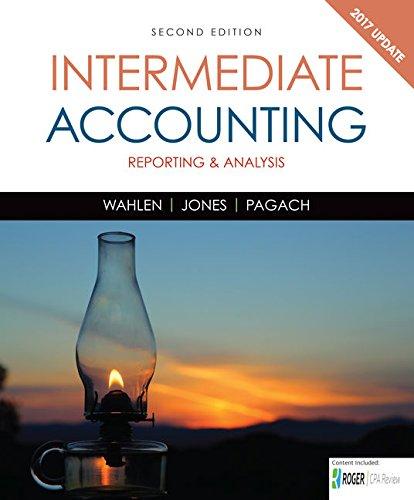
1.
Identify the cost assigned to land, buildings, and equipment.
1.
Explanation of Solution
Determination of cost:
The procurement or acquisition cost of “property, plant and equipment” comprises of all costs that are required to obtain the benefits to be derived from the asset.
Calculate the cost assigned to land:
Therefore, the cost assigned to land is $88,000.
Calculate the cost assigned to building:
Therefore, the cost assigned to building is $110,000.
Calculate the cost assigned to equipment:
Therefore, the cost assigned to equipment is $22,000.
Working notes:
(1) Calculate the percentage of appraisal for land:
(2) Calculate the percentage of appraisal for building:
(3) Calculate the percentage of appraisal for equipment:
(4) Calculate the amount of total cost:
| Acquisition cost | $200,000 |
| Appraisal | $20,000 |
| Total cost | $220,000 |
Table (1)
2.
Journalize entries to value property, plant and equipment of Corporation G.
2.
Explanation of Solution
Property, Plant, and Equipment:
Property, Plant, and Equipment refers to the fixed assets, having a useful life of more than a year that is acquired by a company to be used in its business activities, for generating revenue.
Journal entry is a set of economic events which can be measured in monetary terms. These are recorded chronologically and systematically.
Accounting rules for Journal entries:
- To record increase balance of account: Debit assets, expenses, losses and credit liabilities, capital, revenue and gains.
- To record decrease balance of account: Credit assets, expenses, losses and debit liabilities, capital, revenue and gains
Prepare journal entry with regard to land and to recognize the increase in fair value of land:
| Date | Account titles and explanation | Debit ($) | Credit ($) |
| Land | 22,000 | ||
| Revaluation surplus | 22,000 | ||
| (To record the fair value of land) | |||
Table (2)
- Land is an asset and it is increased. Therefore, debit land account by $22,000.
- Revaluation surplus is a component of
stockholders’ equity and it is decreased. Therefore, debit revaluation surplus account by $22,000.
Prepare journal entry with regard to buildings:
| Date | Account titles and explanation | Debit ($) | Credit ($) |
| 6,000 | |||
| Building | 6,000 | ||
| (To record the depreciation for building) | |||
Table (3)
- Accumulated depreciation is a contra asset account and it is decreased. Therefore, debit accumulated depreciation account by $6,000.
- Building is an asset and it is decreased. Therefore, credit building account by $6,000.
Prepare journal entry to record the increase in value of building:
| Date | Account titles and explanation | Debit ($) | Credit ($) |
| Building (6) | 2,000 | ||
| Revaluation surplus | 2,000 | ||
| (To record the increase in value of building) | |||
Table (4)
- Building is an asset and it is increased. Therefore, debit building account by $2,000.
- Revaluation surplus is a component of stockholders’ equity and it is increased. Therefore, credit revaluation surplus account by $2,000.
Prepare journal entry with regard to equipment and record the decrease in the value of equipment:
| Date | Account titles and explanation | Debit ($) | Credit ($) |
| Loss on impairment (7) | 3,000 | ||
| Equipment | 3,000 | ||
| (To record the decrease in value of equipment) | |||
Table (5)
- Loss on impairment is a component of stockholders’ equity and it is decreased. Therefore, debit loss on impairment account by $3,000.
- Equipment is an asset and it is decreased. Therefore, credit equipment account by $3,000.
Working notes:
(5) Calculate accumulated depreciation:
(6) Calculate the increase in value of building:
(7) Calculate the decrease in value of equipment:
Want to see more full solutions like this?
Chapter 10 Solutions
Cengagenowv2, 1 Term Printed Access Card For Wahlen/jones/pagach’s Intermediate Accounting: Reporting And Analysis, 2017 Update, 2nd
- I need help with this general accounting question using standard accounting techniques.arrow_forwardInnovations Inc. had a $38,000 beginning inventory and a $45,000 ending inventory. Net sales were $215,000; purchases were $110,000; purchase returns and allowances were $5,000; and freight-in was $9,000. Cost of goods sold for the period is $107,000. What is Innovations Inc.'s gross profit percentage?arrow_forwardCompute Lancaster taxable income for the year.arrow_forward
- Can you help me solve this general accounting problem with the correct methodology?arrow_forwardI am looking for the most effective method for solving this financial accounting problem.arrow_forwardCould you help me solve this financial accounting question using appropriate calculation technical.arrow_forward
 Financial Accounting: The Impact on Decision Make...AccountingISBN:9781305654174Author:Gary A. Porter, Curtis L. NortonPublisher:Cengage Learning
Financial Accounting: The Impact on Decision Make...AccountingISBN:9781305654174Author:Gary A. Porter, Curtis L. NortonPublisher:Cengage Learning
